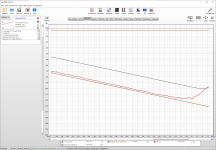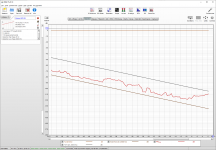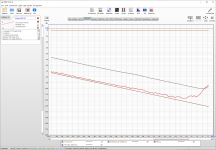Most are aware of the ESS IMD hump of ES90x8 dacs. Unfortunately the same hump is also present in ES9822PRO adc. So something to do with ESS dac/adc architecture.
Here are 2 IMD vs. Level measurements of the same dac (AK4493SEQ) using ES9822PRO and AK5394. Should not be too difficult to guess which is ES9822PRO 🙂
Here are 2 IMD vs. Level measurements of the same dac (AK4493SEQ) using ES9822PRO and AK5394. Should not be too difficult to guess which is ES9822PRO 🙂
Attachments
Thanks for making this test and sharing it.
Let's hope there is a cure for this as with the DACs.
Do you know if the rising distortion at the high levels is caused by the AK4493 or the ES9822PRO?
Let's hope there is a cure for this as with the DACs.
Do you know if the rising distortion at the high levels is caused by the AK4493 or the ES9822PRO?
I'm not sure there is a real cure for this with ESS DACs other than hiding the hump by raising the noise floor (e.g. with lower MCK).
Rising distortion at high levels is probably due to both AK4493 and ES9822PRO (and AK5393 in the other graph). Although with ES9038Q2M the high level distortion rise is a bit smaller.
Rising distortion at high levels is probably due to both AK4493 and ES9822PRO (and AK5393 in the other graph). Although with ES9038Q2M the high level distortion rise is a bit smaller.
I'm tempted to think all ESS products, DAC's and ADC's, use the conceptually same delta-sigma modulator scheme and thus have that specific modulation artifacts that accumulate in a visible hump when the noise floor is low enough. Newer products will fare a bit better but it still is always there.Most are aware of the ESS IMD hump of ES90x8 dacs. Unfortunately the same hump is also present in ES9822PRO adc. So something to do with ESS dac/adc architecture.
Looking at the single tone distortion residual with massive time-domain averaging will expose the characteristic ripple in the transfer function quite well, but high resolution FFT spectra of single tones vs level (and vs DC offset) will also show the modulation patterns right away without time-domain averaging.
With the multichannel DACs there might be a way to reduce the patterns to insignificance by summing the channels, fed with just the right set of digital DC offset levels so that the modulation artifacts average out (or might even fully cancel for most of the signal range). If I had an Okto or Topping DM7 I could put that hypothesis to test but I don't own one.
For the ADC, I cannot think of any feasible solution, though.
I would think the ESS ADC is not a good choice to do detailed measurement of ESS DACs wrt their "humpiness".
BTW the ES9822PRO hump in Cosmos ADC was already discussed on ASR last year: https://www.audiosciencereview.com/forum/index.php?threads/e1da-cosmos-adc.27038/post-1025410
I'm tempted to think all ESS products, DAC's and ADC's, use the conceptually same delta-sigma modulator scheme and thus have that specific modulation artifacts that accumulate in a visible hump when the noise floor is low enough. Newer products will fare a bit better but it still is always there.
The use the so called Hyper stream algorithm (watch ESS video about), as this is not on public! So nothing to do with traditional SDM. As an empiric try and error one. So results may in one way OK in and other as crappy. AKM with the 4490...4493xx series as 3thrd order is also as bit LOW to get good SNR. So the new multi bit as 5thd order & lower switching charges may a winner.
What me more concern, is the more rising close in PN given from ESS ADC as DAC. Easy to check as using RME ADC/DAC as both AKM and ADC/DAC as AKM/ESS combination using the so named Steady Clock PLL O😉. Not to forget may the pitta in the upcomming ADI-2 Pro 2/4 as fully ESS solutions as the seams to give up AKM in some series.
I dont get it
so why don’t DAC Manufacturers just use a Cirrus chip or Texas Instruments or something else?
so why don’t DAC Manufacturers just use a Cirrus chip or Texas Instruments or something else?
At least some DAC manufacturers seem to compete with numbers and ESS chips are especially good at that. But regarding ADCs ES9822PRO is currently the best performing audio ADC chip even with all its faults. It would be nice if AKM, Cirrus, TI or others would come up with something similar but that may not happen as the market for audio ADCs is probably quite limited.
At least some DAC manufacturers seem to compete with numbers and ESS chips are especially good at that. But regarding ADCs ES9822PRO is currently the best performing audio ADC chip even with all its faults. It would be nice if AKM, Cirrus, TI or others would come up with something similar but that may not happen as the market for audio ADCs is probably quite limited.
i just don’t get it.
i personaly havent heard a great ESS DAC at all
the only one I heard which was good not great was the benchmark DAC3.
but all the rest have the hump or just have an ’ off’ timbre.
cirrus has a new flagship.
is there anything wrong with that chip?
thanks
I think the dac chip is just one piece in the puzzle. Other stuff such as PSU, Vref, clocking, output stage may be more important for how the end product sounds so it should be quite possible to make good or bad sounding dac devices with most dac chips.
But the big elephant in the room is that many find the sound differences between dacs to be quite miniscule. There have been very few (if any) controlled DBTs that show the differences to be audible and identifiable.
But the big elephant in the room is that many find the sound differences between dacs to be quite miniscule. There have been very few (if any) controlled DBTs that show the differences to be audible and identifiable.
which one?cirrus has a new flagship.
is there anything wrong with that chip?
I think the dac chip is just one piece in the puzzle. Other stuff such as PSU, Vref, clocking, output stage may be more important for how the end product sounds so it should be quite possible to make good or bad sounding dac devices with most dac chips.
But the big elephant in the room is that many find the sound differences between dacs to be quite miniscule. There have been very few (if any) controlled DBTs that show the differences to be audible and identifiable.
every DAC I’ve tried sounds different.
yeah some DACs are harder to tell than others. For sure.
but most are quite different sounding.
Now when we are talking DAC differences they are minute but at the same time huge.
i know that doesn’t make sense. But because we are talking timbre , weight of instruments , time domain , etc. it has a profound effect on the overall sound
if that makes more sense.
to my ears ESS chip DACs had a certain sound sig
so do Cirrus.
i don’t have much experience with AKM to be honest so there I dont know
and sure the chip is one piece of the puzzle , but I still think one can hear the underlying tone or sound sig of the chip underneath it all. I mean it only makes sense. Or everyone would be using the same chip.
- Home
- Design & Build
- Equipment & Tools
- Return of the ESS hump


